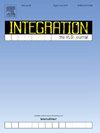Design of self-recovering low-cost multiple-node-upset-tolerant latch
IF 2.2
3区 工程技术
Q3 COMPUTER SCIENCE, HARDWARE & ARCHITECTURE
引用次数: 0
Abstract
The radiation effects induced by particles in the radiation environments are the serious threat to the normal operation of electronic devices, and the single event effect can lead to soft errors in latches and destroy the stored data. With the technology scaling down, the Multiple Node Upset (MNU) induced by single event charge sharing has become the emerging reliability challenge of radiation-hardened designs. The radiation performance of latches can be improved by adding enough redundant nodes through spatial redundancy technique, but the overhead is significant and unacceptable. Therefore, in this work a Low-Cost MNU-Tolerant (LCMT) latch is proposed. By adding two redundant nodes to form the feedback loops and combining with layout-level techniques, the proposed LCMT latch can self-recover from MNU. SPICE simulations and 3D TCAD mixed-mode simulations were carried out with 65 nm commercial technology model to verify the robustness of the proposed latch to MNU. Compared with some existing radiation-hardened latches, the proposed LCMT latch has comparable or higher Single Event Upset (SEU) tolerance, lowest delay, lower power consumption, lower Power Delay Product (PDP), and lower delay sensitivity to Process, Voltage, and Temperature (PVT) variations. Compared with the same type of MNU-tolerant latch designs, the proposed LCMT latch saves about 60 % area overhead and about 46 % PDP.
求助全文
约1分钟内获得全文
求助全文
来源期刊

Integration-The Vlsi Journal
工程技术-工程:电子与电气
CiteScore
3.80
自引率
5.30%
发文量
107
审稿时长
6 months
期刊介绍:
Integration''s aim is to cover every aspect of the VLSI area, with an emphasis on cross-fertilization between various fields of science, and the design, verification, test and applications of integrated circuits and systems, as well as closely related topics in process and device technologies. Individual issues will feature peer-reviewed tutorials and articles as well as reviews of recent publications. The intended coverage of the journal can be assessed by examining the following (non-exclusive) list of topics:
Specification methods and languages; Analog/Digital Integrated Circuits and Systems; VLSI architectures; Algorithms, methods and tools for modeling, simulation, synthesis and verification of integrated circuits and systems of any complexity; Embedded systems; High-level synthesis for VLSI systems; Logic synthesis and finite automata; Testing, design-for-test and test generation algorithms; Physical design; Formal verification; Algorithms implemented in VLSI systems; Systems engineering; Heterogeneous systems.
 求助内容:
求助内容: 应助结果提醒方式:
应助结果提醒方式:


